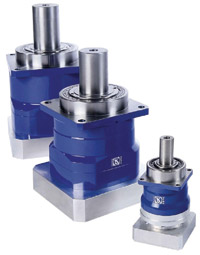
Posted to News on 26th Mar 2012, 00:00
Backlash versus lost motion
Understanding backlash, lost motion, repeatability and precision allows the designer to choose the best servo gearhead for his application.

>The continuing demand for improved industrial productivity has fuelled the development of high performance servomechanisms capable of dynamic precision movement. Precision planetary servo gearheads are often an essential component of a servo system, providing a mechanical advantage plus the ability to control large loads quickly in an economical fashion. Servo gearheads provide speed reduction, torque manipulation and reduced inertia.
>In choosing the correct servo gearhead, a designer must consider backlash, lost motion, repeatability and precision. Unfortunately, because of differences in semantics and methods of measurement, there is often confusion regarding these factors. This is especially true for backlash and lost motion, which are often erroneously believed to be synonymous in describing the relative motion of the gearhead output position in relation to the input movement. So let's look at the difference between these performance factors and examine their relative importance.
>Simply stated, all mechanical devices, even a bar of solid steel, have some elasticity. Thus, a small torque can be applied to the input of a device and be absorbed in the windup of the device, with no movement at the output. This is the lost motion. Backlash of a gearbox is a component of lost motion. Backlash is the amount by which the width of a gear's tooth space exceeds the thickness of an engaging tooth measured at the pitch circle of the gears. Backlash, sometimes termed slop, lash, free-play, or simply play, is an angular quantity due to the gear's circular geometry. This can be termed clearance backlash.
>Backlash is necessary for clearance to accommodate manufacturing errors, provide space for lubrication and allow for thermal expansion of components. The combination of manufacturing errors and/or incorrect lubrication is detrimental to the value of backlash in operation. Poor manufacturing quality results in smaller contact areas of the meshing teeth, resulting in high contact pressure on the components. This pressure may exceed the allowable pressure of the lubrication, which leads to metal-to-metal contact, resulting in high wear. Designs with gear teeth of proper hardness, surface finish, and quality level allow the lubrication film to be maintained which eliminates metal-to-metal contact and wear. Lubricants are essential to minimising backlash and the appropriate choice of lubricant is application specific. Oil is superior to grease in its allowable contact stress capacity, heat dissipation and film forming characteristics, which permit it to penetrate tight clearances between precision gears.
>Measuring backlash
>In servo-mechanical transmissions, backlash is measured at the output shaft of the gearhead while holding the input shaft rigid. The ambiguity in published values for backlash from various manufacturers is due to the fact that there is no standard process for measuring backlash. Is the specified value the maximum value or average? Is it a plus or minus value or the total? Is any force used to rotate the output in order to ensure full-face contact on the gears and the bearing rollers?
>Quality manufacturers will apply some amount of torque when measuring backlash and call the result torsional backlash, and this is where the terminology gets confusing. Because a force is applied, some manufacturers will call torsional backlash lost motion because it involves rotating the output with no rotation at the input. The lost motion includes the deflection of the gear teeth for full-face contact, motion as a result of bearing clearances, as well as friction and clearance backlash. Torsional backlash is synonymous with lost motion and common sense tells us that the amount of force applied will greatly affect the values of lost motion or torsional backlash. The manufacturing quality of the gearhead and the shape of the teeth are the major determinants of torsional backlash. Manufacturing irregularities result in unequal tooth load distribution and skewed tooth engagements, resulting in deflections that affect the torsional backlash or lost motion values. Some manufacturers claim zero backlash in their gearboxes due to the negative connotation associated with backlash. It is important to point out that this zero backlash claim is in regard to the actual free-play and much different than the torsional backlash. However, one may ask, can any mechanical device be manufactured with zero clearance or free play?
>Lost Motion describes the condition in which an input to a mechanism yields no corresponding displacement at the output. Lost motion is one of the principal causes of positional uncertainty in a motion system. Lost motion is not typically specified as such, since it is a function of the torque applied in a particular application. However, a useful alternative is the stiffness of the gearhead, sometimes termed torsional rigidity or torsional stiffness.
>Stiffness of the gearhead is determined by rigidly mounting the unit, locking the input, applying a series of unidirectional torque loads to the output and, for each value, measuring the angular dis-placement at a number of positions about the circumference of the output shaft. The resulting data series is linear when the torque load nears the capacity of the gearhead. The slope of the line in this area defines the torsional stiffness in units of force per angle increment. When this test is performed with bi-directional rotation and torque application, backlash contributes to the results. The difference between the data upon reversal indicates the lost motion or torsional backlash as a function of the applied torque.
>Backlash, or lost motion, is not an issue in the case of continuous single direction motion. Here the resistance of the load forces the meshing gear teeth into contact that is maintained by constant unidirectional gear rotation. However, any reversal of motion (and some cyclical horizontal motion with high inertia) requires that the teeth first disengage then re-engage on the opposite tooth surfaces. Unless programming of the servo control system compensates for backlash, this will give rise to positioning errors in many applications. If you know what the backlash value is, and more importantly what it will be after many hours of operation under load, you can easily compensate for it in your servo system.
>Backlash can be negated by obtaining position data for control feedback at the critical point-of-motion rather than at the end of the driving motor shaft. While a motor shaft-mounted sensor may be needed for control of the motor itself, locating an additional transducer for positioning control at the critical motion point bypasses the train of components along with their lost motion characteristics. Another method of compensating for backlash is in the drive manufacturer's software. The system will overshoot or undershoot the calculated position based on the amount of backlash entered as a software parameter.
>For single direction motion systems, where backlash has been shown to be inconsequential, adequate torsional stiffness is critical to achieving duty cycle objectives. If the torsional rigidity of the drivetrain is not rigid enough to resist deflections due to the dynamic loads, the output shaft will lag the motor shaft and its feedback transducer (resolver or encoder). Duty cycles must be limited to allow the system time to reach stability, which compromises throughput capacity.
>Unlike backlash, no servo controller programming or adjustment can fully compensate for insufficient stiffness. The stiffness and rigidity characteristics of the motion components fundamentally limit the dynamic response capability of a system. Attempts to increase performance in this case will be frustrated by servo instability (position hunting) or unacceptable settling time. The types of couplings and line-shafting also have a large impact on the system stiffness and dynamic response. It is equally important to consider the torsional rigidity of all these components between the output shaft of the gearhead and the load to get a true measurement of the lost motion in a system. Even if the compromised throughput is tolerable, the lack of stiffness and the resulting oscillations may result in premature failure of the system due to fatigue of some component.
>Keep in mind the objectives of the motion system and the gearhead's significant influence in determining system performance. While people may think they need zero backlash, the reality may be that backlash readings not exceeding 2 arcmins may be acceptable. This angular error in a gearhead that is rotating an 8in diameter roll equates to a maximum of 0.001in of movement at the roll surface. Designers must consider what is important: precision, position, repeatability or reliability. The combination of these factors will determine the most suitable gearbox for the application.







